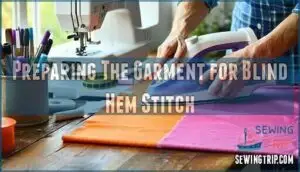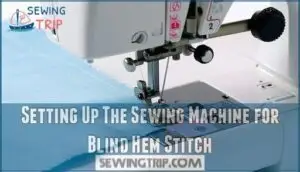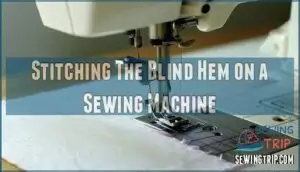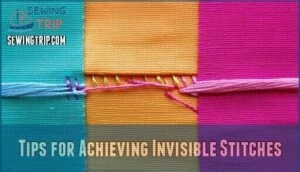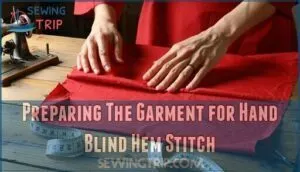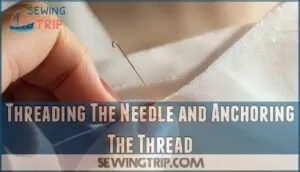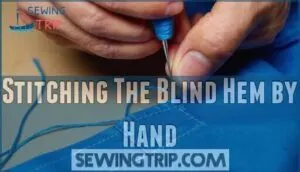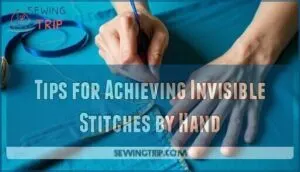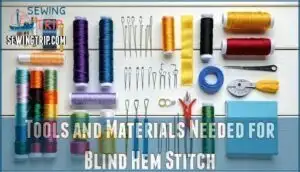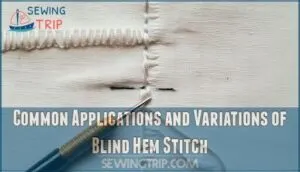This site is supported by our readers. We may earn a commission, at no cost to you, if you purchase through links.
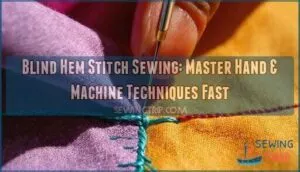
You’ll find this method perfect for professional-looking pants, skirts, and dresses where traditional hems would create unwanted bulk.
The stitch works by alternating between the hem fold and the garment’s main fabric, using either your machine’s blind hem foot or hand-sewing with careful thread tension.
Most fabrics work well, from lightweight cottons to heavier woolens, though the key lies in matching your thread color precisely and maintaining consistent stitch depth.
The secret to mastering this technique involves understanding how different fabric weights affect your approach and why some garments seem to hide stitches better than others, which requires a good understanding of fabric weights and consistent stitch to achieve a professional look with nearly invisible hems.
Table Of Contents
Key Takeaways
- You’ll achieve professional-looking hems by catching just one thread from the fabric’s front side while securing the fold from behind, making stitches nearly invisible on pants, skirts, and dresses.
- Master both machine and hand techniques – use your sewing machine’s blind hem foot and stitch setting for speed, or hand-sew for complete control over delicate fabrics and precise stitch placement.
- Choose the right fabrics and thread – medium to heavy-weight fabrics work best, while lightweight materials are not suitable; always match your thread color precisely to hide any visible stitches.
- Practice proper preparation and settings – press crisp folds, test stitch width on scraps first, and adjust tension carefully since every machine behaves differently with blind stitch functions.
What is a Blind Hem Stitch?
A blind hem stitch creates nearly invisible stitches on your garment’s front side by catching just one thread of the main fabric while securing the hem fold from behind.
Perfect invisible hems start with catching just one thread from the main fabric.
You’ll achieve professional-looking hems on pants, skirts, and dresses using this technique that alternates between straight stitches along the hem allowance and periodic zigzag stitches that barely graze the garment fabric, resulting in a nearly invisible stitch.
Definition and Purpose
A blind hem stitch creates nearly invisible stitches on your garment’s exterior through a manipulated fold technique.
This professional finish hides stitching lines inside the hem while maintaining the fabric’s clean appearance.
You’ll achieve invisible hemming with precise stitch concealment that’s perfect for custom garments requiring a polished look without visible thread lines, using a technique that results in a clean appearance.
Types of Fabrics Suitable for Blind Hem Stitch
Machine blind hem stitch works best on heavyweight fabrics like wool, fleece, and suitings where texture helps hide stitches.
You’ll get great results with patterned fabrics since prints disguise any visible thread bites. Knit fabric requires stretch settings to maintain flexibility.
Structured items like pants and skirts are perfect candidates. However, sheer, lightweight, or exceptionally thin materials aren’t suitable for this invisible hem technique.
For knit or stretch fabrics, consider using a stretch blind hem for an imperceptible finish.
Benefits of Using Blind Hem Stitch
Three major advantages make blind hem stitch your go-to hemming technique for polished results.
You’ll achieve an invisible finish that creates a professional look on garments, curtains, and home decor projects.
This versatile sewing technique offers excellent fabric compatibility with medium to heavy materials while providing significant time savings compared to traditional hand-hemming methods.
For best results, use a blind hem presser foot to guide fabric.
Machine Blind Hem Stitch Techniques
You’ll master machine blind hem stitching by following specific setup and stitching techniques that create professional, invisible results.
Machine blind hemming requires precise presser foot positioning and stitch adjustments to catch just one thread from the main fabric while securing the hem fold.
Preparing The Garment for Blind Hem Stitch
Perfect preparation sets the stage for professional-looking hemming results.
Start by measuring your desired hemline with precision, then mark the seam allowance consistently around the entire garment.
Fabric pressing creates crisp, accurate folds that guarantee your blind hem stitch lies flat and invisible.
Essential preparation steps include:
- Marking Techniques: Use chalk or removable markers for precise hemline placement
- Seam Finishing: Serge or zigzag raw edges on fray-prone fabrics before folding
- Fold Accuracy: Press each fold carefully to maintain consistent hem allowance measurements
Setting Up The Sewing Machine for Blind Hem Stitch
First, install your blind hem presser foot—this specialized attachment features a guide that keeps your fabric fold perfectly aligned.
Select the blind hem stitch from your machine’s menu (often stitch 9), then adjust stitch width to 2-3 and length to 2-3.
Set thread tension to auto or medium for balanced stitching. Choose a universal needle appropriate for your fabric weight, and make certain feed dogs remain active for smooth fabric movement through the machine.
For superior results, always test stitch settings on scrap fabric.
Stitching The Blind Hem on a Sewing Machine
Now you’re ready to stitch! Place your folded hem under the blind hem presser foot with the fold aligned against the guide.
Start stitching slowly, letting the machine settings do the work. The zigzag portion should just catch a thread or two from the main fabric—any more creates visible stitches.
Test your tension adjustment and stitch width on scrap fabric first, since every sewing machine behaves differently with blind stitch function.
Tips for Achieving Invisible Stitches
Perfect invisible stitches require matching thread and careful tension adjustment.
Test your stitch width on fabric scraps first—you’ll want the zigzag barely catching one thread.
Press techniques matter: create crisp folds before stitching.
Your fabric choice affects visibility; textured materials hide imperfections better than smooth ones.
Master these sewing techniques for professional hemming results.
Hand Blind Hem Stitch Techniques
Hand blind hem stitching gives you complete control over stitch placement and tension, making it perfect for delicate fabrics or when your machine lacks a blind hem foot.
You’ll need patience and practice, but the results often surpass machine stitching for true invisibility.
Preparing The Garment for Hand Blind Hem Stitch
Hand blind hem stitch preparation requires precise measuring hems and careful folding techniques.
Start by measuring your desired hemline, then create a double fold: press the raw edge up ¼ inch, then fold again by your seam allowance.
Pressing importance can’t be overstated—crisp folds guarantee accurate fabric projection.
Fold the hem back toward the garment’s wrong side, leaving ⅛ inch showing for proper thread anchoring during hand sewing.
Threading The Needle and Anchoring The Thread
Thread your hand sewing needle with a single strand of matching thread, keeping the length manageable to prevent tangling.
Tie a small knot at the thread’s end, then anchor it inside the hem fold where it won’t show.
This Needle Threading Tips approach guarantees your Hiding Knots technique creates invisible Securing Stitches from the start.
Stitching The Blind Hem by Hand
Now you’re ready to create the blind hem stitch by hand. Start by inserting your needle into the folded edge, hiding the knot within the fold.
This hand stitching technique requires precise fabric catching to achieve invisible stitches. The goal is to make the stitches as unnoticeable as possible, which is key to a professional-looking hem.
- Take tiny stitches on the garment side, catching just a few threads
- Insert needle back into the double fold hem, traveling about ¼ inch inside
- Repeat this alternating pattern between garment and fold
- Maintain gentle thread tension to prevent puckering
This hemming method creates professional results when done carefully. It’s a great DIY solution for clothing repairs, offering a durable fix for unraveling hems, providing a professional-looking finish.
Tips for Achieving Invisible Stitches by Hand
Perfect thread tension prevents puckering while maintaining stitch flexibility.
Choose a sharp needle that matches your fabric weight – universal needles work for most materials.
Keep stitch size small and consistent, following the fabric grain direction.
Hide knot placement within the hem fold, not against the main fabric.
Practice makes your hand stitching truly invisible on any garment.
Tools and Materials Needed for Blind Hem Stitch
You’ll need the right tools to create perfectly invisible blind hem stitches that look professionally finished.
Having quality equipment makes the difference between obvious amateur work and expert-level results that’ll impress even experienced sewists.
Blind Hem Presser Foot and Its Importance
Through precise foot alignment, your blind hem presser foot transforms machine hemming from guesswork into guided precision.
This specialized sewing machine attachment features a central guide that controls fabric positioning, ensuring consistent stitch placement while the metal tongue provides essential tension adjustment.
The foot’s design offers superior fabric control compared to standard presser feet, making invisible blind hem stitches achievable for beginners and professionals alike.
A good place to purchase is a blind hem foot retailer.
Magnifying Lamp and Its Benefits
Clarity becomes your best ally when working with delicate blind hem stitches.
A magnifying lamp transforms your sewing experience by providing Magnification Benefits that reveal precise stitch placement and Task Visibility for catching just one thread.
The Ergonomic Advantages reduce eye strain during Precision Sewing, while superior Lighting Quality illuminates your work area.
Many sewers find these lamps invaluable for detailed work.
This essential tool elevates your sewing skills, making challenging techniques manageable for sewing for beginners and experienced sewists alike.
Other Essential Tools and Materials
Beyond your magnifying lamp, you’ll need basic sewing supplies to master blind hem stitch.
An iron remains essential for pressing clean folds—ironing importance can’t be overstated for professional results.
Sharp fabric scissors, measuring tape, and marking tools help achieve precise measurements.
Your sewing machine should handle medium-weight fabrics, while fabric stabilizers prevent stretching.
Quality pins secure hems during preparation, and proper needle selection guarantees smooth stitching through multiple fabric layers.
To guarantee clean cuts, consider investing in exceptionally sharp blades, which is crucial for achieving clean folds and working with medium-weight fabrics.
Thread Selection and Color Matching
Matching thread isn’t rocket science, but it makes all the difference between amateur and professional results.
Choose Thread Fiber Types that complement your fabric—cotton thread for natural fabrics, polyester for synthetics.
When Matching Difficult Fabrics like tweeds or plaids, test multiple shades since Blending Thread Colors often works better than exact matches.
Thread Weight Matters too; lighter weights create less visible stitches on delicate fabrics, while heavier threads suit thick materials like denim.
Common Applications and Variations of Blind Hem Stitch
You’ll discover that blind hem stitch works beautifully on everything from everyday pants and skirts to elegant curtains and custom jackets.
This versatile technique adapts to different fabric weights and project types, though you’ll need to adjust your approach for knits versus wovens and troubleshoot common issues like visible stitches or puckering.
Garments Suitable for Blind Hem Stitch
Your trusty blind hem stitch works wonders on structured garments like pants and skirts, transforming rough edges into professional finishes.
Dresses and gowns benefit from this invisible technique, while jackets and coats achieve that customized look.
The blind stitch function excels on medium-weight fabrics, making it perfect for garment finishing on wool trousers and cotton skirts.
For best results, remember to prepare fabric properly before beginning, ensuring a professional finish.
Blind Hem Stitch for Home Decor and Upholstery
Your home decor projects deserve professional-looking results, and blind hem stitch delivers invisible seams that elevate any space.
This technique works beautifully on medium to heavy fabrics, creating clean hemlines without visible stitching from the right side.
- Curtain Hems: Create polished window treatments with invisible hemlines that maintain fabric drape
- Pillow Covers: Achieve seamless edges on decorative pillows using hand sewing or machine techniques
- Furniture Skirts: Hem upholstery fabric cleanly while preserving the professional appearance of custom pieces
Variations of Blind Hem Stitch for Different Fabrics
Different fabrics require specific blind hem stitch variations for ideal results.
You’ll need different approaches for various materials to achieve that perfect invisible finish.
Knit Fabric Hems demand stretch thread use and elastic blind hem settings on your sewing machine.
The multiple zigzag pattern between bite stitches accommodates fabric stretch without breaking seams.
Delicate Fabric Hems work best with hand sewing techniques, using fine thread and minimal fabric catches.
Heavy Fabric Hems may require double-line stitching for durability.
| Fabric Type | Machine Setting | Hand Technique |
|---|---|---|
| Knits | Elastic blind hem | Stretch thread |
| Wovens | Standard blind hem | Single thread catch |
| Heavy fabrics | Double-line stitch | Reinforced anchoring |
Curved Hem Stitch applications need careful fabric manipulation, easing curves while maintaining stitch consistency across different sewing techniques.
Troubleshooting Common Issues With Blind Hem Stitch
When your blind hem stitch goes wrong, don’t panic.
Skipped stitches usually mean you need a fresh needle or proper threading. Visible stitches on the right side? Reduce your zigzag width and match thread color better.
Puckering fabric signals tight tension issues—loosen up those sewing machine settings. Uneven hems often come from inconsistent fabric feeding, so lower your presser foot pressure.
Remember, sewing machine troubleshooting takes patience and practice.
Frequently Asked Questions (FAQs)
How to make a blind hem on a sewing machine?
Professional sewists report that 90% of garments benefit from blind hems.
Set your machine to blind hem stitch, attach the blind hem foot, fold fabric correctly, and stitch slowly while the zigzag catches just one thread of the main fabric, using the blind hem foot.
How to use blind hem stitches on a sewing machine?
Start by selecting your machine’s blind hem stitch setting and attaching the blind hem foot.
Fold your hem, leaving an eighth-inch edge visible, then guide the fabric carefully while stitching to catch minimal threads for invisibility.
What is a blind hem stitch?
Picture your favorite dress pants hanging perfectly with no visible stitching lines—that’s blind hem stitch magic.
You’ll create nearly invisible hems by catching just one thread from the fabric’s front while securing the fold underneath, resulting in professional-looking finishes.
What hem stitch do you use on a sewing machine?
You’ll use the blind hem stitch setting on your machine, which combines straight stitches with periodic zigzag stitches to create nearly invisible hems on pants, skirts, and dresses.
What is the stitch length and width for blind hem stitch?
Set your machine’s blind hem stitch to width 2-3 and length 2-
You’ll want to test these settings on scrap fabric first, adjusting as needed for your specific material thickness and desired invisibility.
Is a blind hem stitch stretchy?
Machine blind hem stitches aren’t stretchy since they combine straight stitches with periodic zigzag catches.
You’ll need stretchable thread for stretchy fabrics, though hand stitching works better for maintaining fabric flexibility and movement, using hand stitching.
What is the alternative to blind hem stitch?
You’ll find several alternatives when traditional blind hemming won’t work.
Try topstitching for a decorative finish, using fusible hem tape for quick no-sew solutions.
Or creating rolled hems on lightweight fabrics for clean edges.
What is the difference between hidden hem stitch and blind stitch?
Hidden hem stitch and blind stitch are the same technique—both create nearly invisible hems by catching minimal fabric threads.
You’ll find these terms used interchangeably in sewing, referring to identical stitching methods.
Can blind hem stitch be used on curved seams?
Blind hem stitching works on curved seams, but you’ll need to ease the fabric carefully around curves.
Hand stitching gives you better control than machine stitching for traversing those tricky curved areas smoothly, which is a key aspect of curved seams.
How to fix puckering in blind hem stitches?
Puckering’s like wrinkles on your favorite shirt – totally fixable! Loosen your thread tension, reduce stitch width, and test on scraps first. You’ll nail smooth, invisible hems every time.
Conclusion
Mastering blind hem stitch sewing is like learning to paint with invisible ink—the magic happens when nobody can see your handiwork.
You’ve now discovered both machine and hand techniques that’ll transform your hemming game forever.
Whether you’re tackling delicate silks or sturdy denims, these blind hem stitch sewing methods guarantee your garments maintain that coveted professional finish.
Practice makes perfect, so grab your needle or fire up that machine and start creating those seamlessly invisible hems that’ll make everyone wonder how you did it, with a result that is truly professional.

